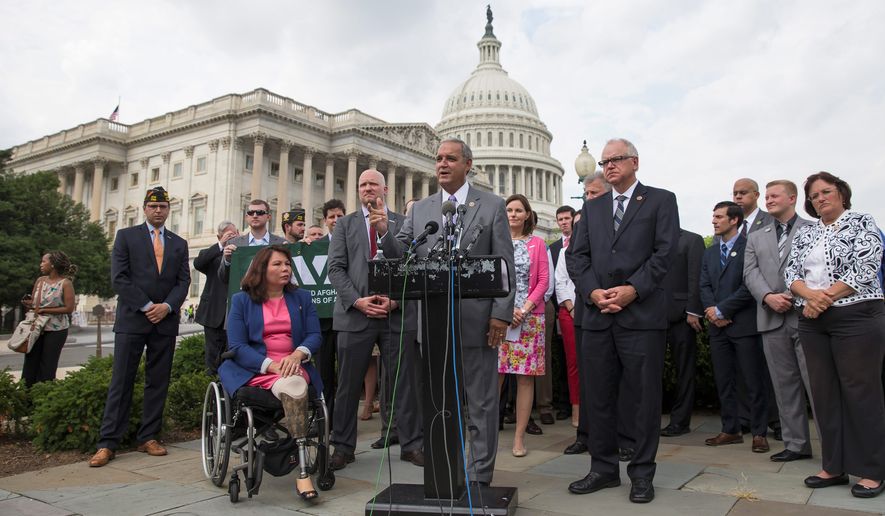Its most oft-cited — and contested — figure in the grim field of veteran suicide research: 22.
That’s what some researchers say is the average number of U.S. service veterans who take their lives every single day, and it’s a statistic that’s fueling efforts by the Obama administration and lawmakers on Capitol Hill to address the plight of struggling veterans.
Cited frequently by President Obama and lamented by veterans organizations, the death toll estimate spurred Congress to pass the Clay Hunt Suicide Prevention for American Veterans Act earlier this year, designed to stem what lawmakers saw as an epidemic of suicides among veterans of the wars in Afghanistan and Iraq.
The number itself, taken from a 2012 Department of Veterans Affairs study, is debated by researchers, and within that number are a number of populations who, other than sharing a background of service as members of the armed forces, are trickier to generalize.
“While that’s a single number that represents a single population, it’s a complex population that’s dynamic,” said Dr. Robert Bossarte, director of the VA’s epidemiology program and co-author of the 2012 study. “Any time you talk about a national number like that, there’s a tremendous amount of activity and change going on behind the scenes.”
Indeed, the study found that suicide rates were highest not among newer recruits but among older veterans — two-thirds of those covered by the research committed suicide after reaching 50 years of age. But suicide rates among younger veterans shot up from 2009 to 2011, according to a 2014 update to the 2012 study.
Men commit suicide at higher rates than women, although the rates for women veterans have gone up in the past two years. Veterans overall are still far more likely to commit suicide than those who did not serve in the military.
The actual count from the 2012 study found that 18 to 22 veterans take their lives every day, out of a total population of about 22 million. The rate held steady in the 2014 update report — though questions persist.
The figure of 22 daily suicides was extrapolated from death certificate information in 21 states that contribute to the national violent-death database. Veterans were tracked from 2001 to 2009, but without data from some of the states with the largest veteran populations, the number is an educated estimate.
There are even some psychiatrists who think that 22 might be a conservative number.
“Many of us think the rate is higher than 22,” said Dr. Craig Bryan, executive director of the National Center for Veterans Studies at the University of Utah. “We don’t want to blow things out of proportion and say it’s much worse, but, at the same time, we don’t want to pretend it’s not a problem. So 22 seems a reasonable estimate to provide based on the evidence.”
The way to get at the full picture of veteran suicide is to get better data that are not based on partial information from state data and extrapolations.
The solution: a labor-intensive study between the VA and the Centers for Disease Control and Prevention to put together a national death index to get a real head count of all veteran deaths since 1979, including suicides.
The report should be released sometime in 2016, Dr. Bossarte said, and researchers are divided on whether the rates would go up or down.
“I’m expecting there will be little change in the number but a change behind the scenes,” Dr. Bossarte said. “That number is reflective of rates of every demographic of veterans. It’s a complex portrait.”
Galvanizing action
The complexities beneath the number also leave some doctors wary of using it so bluntly.
“We don’t think it’s the best way to talk about it,” said Dr. Caitlin Thompson, VA’s deputy director of suicide prevention. “It’s an easy thing for people to grab onto. At least it’s getting awareness out there that it’s a significant issue and one we’re all working really, really hard on, but there’s certainly other ways it should be done.”
Still, putting a finite tally on the problem has galvanized action, said Dr. Bryan.
“Suicide is the third-biggest cause of death among teenagers and young adults,” he noted, but many medical conditions that are responsible for far fewer deaths than suicide receive more funding than suicide research.
“That would be tragic if people became numb to the statistic at a place where we’re actually starting to know what works, starting to publish papers and implement life-saving actions, about to cross the finish line, and we’ve collapsed.”
Dr. Bryan said he is expecting the veteran suicide rate to rise in the next major update.
“I don’t know that we as a society have yet really fully committed ourselves to doing what needs to be done to end this purge,” he said.
While there are predictors of suicidal tendencies, including depression, post-traumatic stress disorder, traumatic brain injuries and alcohol abuse, the trends can be confounding. Analysts can’t say why there has been an increase in younger veterans and women taking their lives.
“That’s the $10 million question for military and veteran mental health,” said Dr. Bruce Capehart, medical director for Iraq and Afghanistan veterans at the VA in Durham, North Carolina.
The research has produced data that upset the conventional wisdom, including the finding that veterans who served in combat zones are at a lower risk for suicide than their comrades who did not.
One study found that suicide rates for servicemen and -women deployed to Iraq or Afghanistan were lower than for veterans who had not gone to war.
The federal government has taken steps to combat the problem and has concluded that providing mental health services does work: Fewer than 25 percent of veterans who committed suicide in the 2012 report had sought mental health care at the VA.
• Anjali Shastry can be reached at ashastry@washingtontimes.com.




Please read our comment policy before commenting.